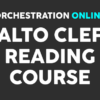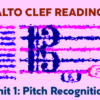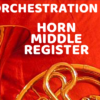I’m listing these two books together, as I’m constantly asked which books a beginning orchestrator should read. Here is my perennial reply: get the Piston text first. It is clear, concise, and well-laid-out, giving you valuable, usable information in simple, memorable words. Read it many times, and try out some of the assignments. Then, when you are absolutely certain that you have the willpower, desire, and aptitude to get serious about your training, then and only then should you invest in the Adler. The Adler is state-of-the-art – but for that, you will have to pay university books store prices, even on Amazon. Get the recordings along with it, those are essential for reference.
« The Technique of Contemporary Orchestration, by Alfredo Casella, edited by Virgilio Mortari
Orchestration: A New Approach »
Related Posts
ALTO CLEF READING COURSE ORIENTATION
Welcome to the Orchestration Online Alto Clef Reading Course, designed to quickly and permanently im
ALTO CLEF READING, UNIT 1: PITCH RECOGNITION
FINDING A USEFUL SYSTEM When I was just about 14, I switched over from the violin to viola in my jun
ALTO CLEF READING, UNIT 2: SCORING
Note: make sure to read my first tip in this course on Alto Clef concerning Pitch Recognition, downl
ALTO CLEF READING UNIT 3A: VIOLA
If you’re new to reading the alto clef, but you’ve taken the time to drill yourself on Pitch Recogni
ALTO CLEF READING UNIT 3B: ALTO TROMBONE
If this is your first look at my Alto Clef Reading Course, jump back to the my first two sections on
ALTO CLEF READING UNIT 3C: CONTRALTO VOICE
This represents the final post in my series, “Alto Clef Reading Tips and Drills.” Make sure that you
ALTO CLEF READING, UNIT 4A: 100 SIGHT-SINGING DRILLS
100 ALTO CLEF SIGHT-SINGING DRILLS By this point in my Alto Clef Reading Course, you should have sha
Orchestration Tip: Horn Middle Register
For better control in delicate scoring, use the horn’s middle register, especially in the octave bet








